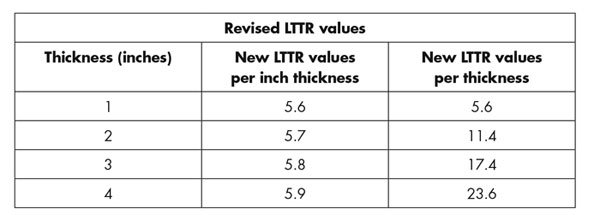In June, the Polyisocyanurate Insulation Manufacturers Association (PIMA) announced its QualityMark-certified R-value program is being updated to incorporate a new test method for determining long-term thermal resistance (LTTR). As a result, new LTTR values are going to decrease from current values. If you are involved in the design, procurement or installation of roof systems that include polyisocyanurate insulation, you should be aware of these upcoming changes.
LTTR test method
Since 2004, LTTR values for polyisocyanurate insulation have been reported using PIMA's QualityMark program, which provides for testing according to CAN/ULC-S770-03, "Standard Test Method for Determination of Long-Term Thermal Resistance of Closed-Cell Thermal Insulating Foams."
In 2011, the U.S. product standard for polyisocyanurate insulation, ASTM C1289, "Standard Specification for Faced Rigid Cellular Polyisocyanurate Thermal Insulation Board," was updated to reference CAN/ULC-S770's 2009 edition. Use of ASTM C1303-11, "Standard Test Method for Predicting Long Term Thermal Resistance of Closed Cell Foam Insulation," also is permitted.
Beginning Jan. 1, 2014, either CAN/ULC-S770-09 or ASTM C1303-11 will be used in the QualityMark program to determine and report LTTR.
Changing LTTR values
The updated LTTR test methods will result in LTTR values that are lower than the LTTR values roofing professionals have become accustomed to using. The new minimum values established by the QualityMark program are shown in the figure. The slightly increasing LTTR per inch thickness indicates a lower cell gas diffusion rate with thicker polyisocyanurate insulation products.
Overall, these new LTTR values represent about a 7 percent decrease from current values.

New minimum LTTR values established by the QualityMark program
Individual polyisocyanurate insulation manufacturers may publish product- and thickness-specific LTTR values greater than those established in the QualityMark program.
PIMA and polyisocyanurate insulation manufacturers have indicated they do not anticipate the change in LTTR values will have any effect on polyisocyanurate insulation's physical properties.
Implementing the change
Manufacturers are expected to provide additional information specific to their products and begin labeling them with the new LTTR values later this year.
The transition to the new values is expected to cause some confusion for designers, product suppliers and distributors, and roofing contractors. Of particular concern are roofing projects that will be designed and possibly bid using this year's LTTR values but installed after the Jan. 1, 2014, implementation date when the new, lower LTTR values are applicable.
NRCA recommends designers specify polyisocyanurate insulation by its thickness—not R-value—based on the required R-value for specific project conditions.
During this transition period, for projects where designers specify polyisocyanurate insulation by R-value, roofing contractors may want to consider submitting requests for information (RFIs) to clarify whether the current or new LTTR values are applicable. This article can be included in RFI submissions.
More information about polyisocyanurate insulation, including NRCA's recommendations for using in-service design R-values, is provided in The NRCA Roofing Manual: Membrane Roof Systems—2011, which can be purchased at shop.NRCA.net.
Mark S. Graham is NRCA's associate executive director of technical services.



